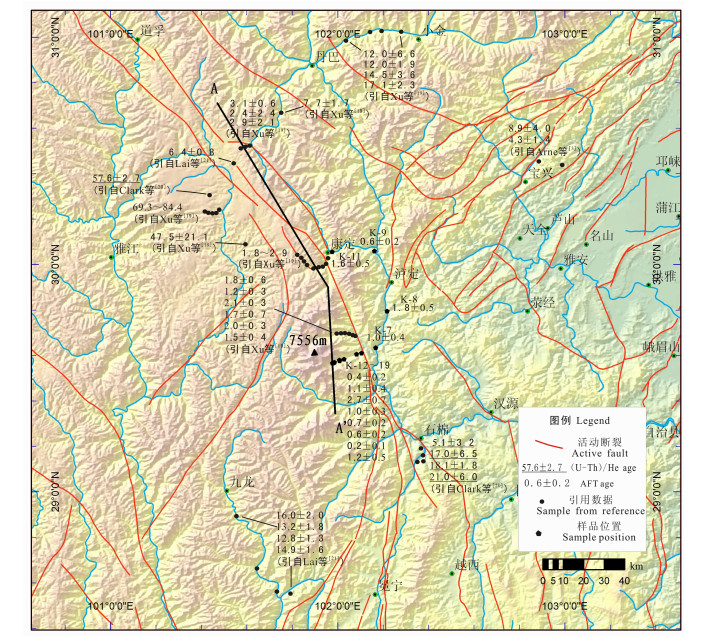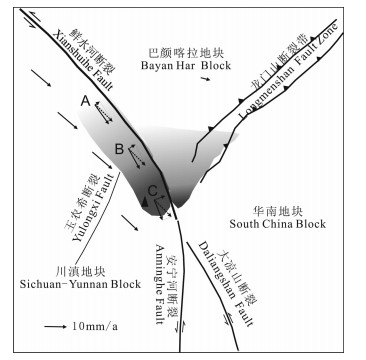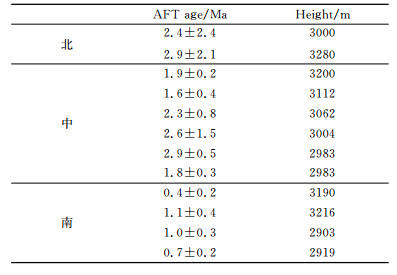2. 国立中正大学地球与环境科学系, 台湾 62102
2. Department of Earth and Environmental Sciences, National Chung-Cheng University, Taiwan 62102, China
青藏高原的隆升过程和隆升机理是国内外地球科学研究的热点问题之一[1~8], 目前主要有两种主流运动学模型:一、Tapponnier等[5]认为青藏高原生长是通过大陆岩石圈斜向俯冲、沿俯冲断裂带大规模走滑运动和以俯冲带为根带的壳幔构造拆离等变形机制实现的; 二、Royden等[6]、Clark和Royden[7]提出的中下地壳层流模型, 强调青藏高原的生长主要通过中下地壳增厚来实现.目前这两种理论的争论仍在进行, 尤其在汶川地震之后[9~11].弄清青藏高原边缘局部快速隆升山体的隆升历史及其与周围断裂活动之间的关系对于认识和恢复高原生长过程和隆升机制极为重要.目前低温热年代学是揭示高原隆升过程的重要方法之一[2~4, 12].
贡嘎山主峰海拔7556 m, 是青藏高原东缘的最高峰, 其隆升过程一直是国内外学者关注的焦点, 同时也是研究青藏高原隆升的重要突破口.鲜水河断裂带是青藏高原东缘重要的左旋走滑断裂带之一, 贡嘎山岩体沿着鲜水河断裂带的南东段分布, 主体位于断裂西侧, 构造地质学研究表明贡嘎山岩体的形成与鲜水河断裂的活动密切相关[12].目前对贡嘎山周边的鲜水河断裂、安宁河断裂等的活动性研究已经比较成熟[13~15], 并用北西向鲜水河断裂左旋走滑与其南部近南北向安宁河断裂左旋走滑兼有逆冲分量的构造运动转换初步解释贡嘎山的构造成因[13].此外, 许多学者对贡嘎山岩体及其周边地区的火成岩体进行了热年代学研究[12, 16~21].本文通过对贡嘎山及其邻区岩石样品进行磷灰石裂变径迹测试和数据分析, 给出了贡嘎山主峰附近地区约1 Ma以来的平均隆升速率, 并结合区域活动断裂研究成果, 初步探讨贡嘎山及其邻近地区隆升与大型走滑活动断裂之间的构造运动转换关系.这一简要报道可为了解2008年汶川地震后川西地区的地震形势提供不可多得的新构造运动背景资料, 同时可为青藏高原东缘构造隆升提供年代依据, 也为研究青藏高原水平运动与垂直运动之间转换提供一个范例.
2 地质背景研究区位于青藏高原东南缘, 地处川滇地块、巴颜喀拉地块和华南地块交接部位.贡嘎山及其邻区发育有鲜水河断裂、安宁河断裂、大凉山断裂和龙门山断裂带等块体边界活动断裂(图 1)[13].鲜水河断裂为略呈北东凸出的弧形弯曲, 北段为走向320°的左旋走滑断裂, 走滑速率为14±2 mm/a, 鲜水河断裂南段为走向340°的左旋走滑兼逆冲断裂, 走滑速率降低为9.6±1.7 mm/a; 安宁河断裂为近南北向的左旋走滑断裂, 走滑速率约为6.5 mm/a; 北北西至近南北向的大凉山断裂为左旋走滑断裂, 兼有逆冲分量, 其中左旋走滑速率为3 mm/a[13].

|
图 1 贡嘎山及其邻区地质简图及采样位置 Fig. 1 Geology map of Gongga mountain and adjacent area and the location of the samples |
据已有区域地质调查成果可知, 在上述块体边界断裂附近存在着大量不同时期的火成岩, 包括元古代火成岩、印支期花岗岩及喜山期花岗岩.以鲜水河断裂和安宁河断裂为界, 元古代火成岩分布在其东侧, 印支期花岗岩和喜山期花岗岩主要分布在其西侧.印支期花岗岩分布较广泛(图 1).喜山期花岗岩则为一整体, 沿着鲜水河断裂南东段分布, 呈长条状, 通常称之为贡嘎山花岗岩体, 也叫折多山岩体, 形成于13~18Ma[12, 16], 其北段被鲜水河断裂错断.贡嘎山主峰位于贡嘎山岩体的最南端, 同时也是川滇地块、巴颜喀拉地块和华南地块三个地块的交接地带.
3 样品的采集、处理与测年结果本次研究共采集样品12块, 包括5块砂岩样品和7块花岗岩样品(图 1).其中, 位于鲜水河断裂西侧贡嘎山附近8块, 包括4块二叠一三叠纪砂岩, 4块喜山期花岗岩.另外4块均位于鲜水河断裂以东、龙门山断裂带以西, 其中2块三叠纪花岗岩, 1块前寒武纪花岗岩, 1块砂岩.野外定位由手持便携式GPS测定, 各采样点海拔高程和经纬度坐标等信息见表 1.
|
|
表 1 贡嘎山地区磷灰石裂变径迹测试数据 Table 1 AFT data of Gongga mountain |
室内磷灰石单矿物分选后, 采用外探测器法对样品进行裂变径迹分析.先将富集后的磷灰石制成薄片, 然后拋光、蚀刻, 蚀刻条件为5.5N, HNO3, 20℃, 20s, 再将蚀刻的薄片加盖后送中国原子能科学研究院492反应堆进行辐照.外探测器采用低铀含量白云母, 蚀刻条件为40%HF, 室温, 20 min. Zeta标定选用国际标准样, Zeta (ξ)参数值为352.4±29;标准玻璃为美国国家标准局SRM612铀标准玻璃.径迹统计用OLYMPUS偏光显微镜, 在放大1000倍浸油条件下完成.实验测试在中国地震局地质研究所地震动力学国家重点实验室完成.
样品的测试结果(表 1和图 2)表明12个样品的磷灰石裂变径迹(AFT)年龄都比较年轻, 主要分布在0.2±0.1Ma~2.7±0.7Ma之间.样品AFT年龄均小于其形成年龄, 表明样品自形成以来经历了一次或多次热事件.除了K-19之外, 单颗粒磷灰石裂变径迹年龄P(x2)均高于5%, 表明各单颗粒年龄的差别属于统计误差, 具有单一的年龄平均值, 样品颗粒径迹年龄可以视为单一年龄, 表示样品经过单一的冷却过程[21].

|
图 2 贡嘎山地区磷灰石裂变径迹样品单颗粒年龄直方图、径迹长度图及放射图ML表示平均长度. Fig. 2 AFT grain age histograms, length histograms and radial plots in Gongga mountain ML stands for mean length. |
本次研究的12个样品AFT年龄分布在0.2±0.1 Ma~2.7±0.7 Ma之间, 平均径迹长度在13.64~15.19 μm之间, 均表明研究区域处于快速冷却(剥露)阶段.鲜水河断裂西侧贡嘎山岩体样品AFT年龄平均值为0.99 Ma, 东侧年龄平均值为1.25Ma.磷灰石裂变径迹的封闭温度为110±10℃[22], 粗略估计研究区域的地热梯度为30±5℃/km, 地表平均气温10℃, 则完全退火线应位于地下3.3±0.8 km, 由此得到鲜水河断裂西侧、东侧的视剥蚀速率分别为3.3±0.8 mm/a和2.6±0.7mm/a.考虑到研究区域的主干河流(大渡河)向东经石棉、汉源、峨边后即汇人了四川盆地, 所以我们认为计算所得的视剥蚀速率应略小于研究区域相对四川盆地的隆升速率, 即鲜水河断裂西侧、东侧相对于四川盆地的隆升速率分别略大于3.3±0.8mm/a、2.6±0.7 mm/a.王庆良等[23]通过水准观测资料测得的贡嘎山现今相对四川盆地的隆升速率至少为5.8mm/a, 表明青藏高原的隆升运动近期有加快的趋势.
结合前人研究成果[3, 19~21]以及本次AFT测年结果(图 3)可知, 青藏高原东南缘的贡嘎山岩体及鲜水河断裂与龙门山断裂所夹的三角区域的AFT年龄小于3Ma, 其西侧、北侧的高原腹地的AFT和磷灰石(U-Th)/He年龄大多在10 Ma以上.上述热年代数据, 不仅反映出青藏高原自新近纪以来整体缓慢隆升, 而且反映出存在着像贡嘎山地区那样的局部受特殊构造条件的影响而快速隆升的现象.

|
图 3 研究区域地形图及AFT和磷灰石(U-Th)/He年龄数据[3, 19~21] Fig. 3 The topographic map of the research area and datum of AFT dating and apatite (U-Th)/He dating[3, 19~21] |
图 4为沿着贡嘎山岩体从北到南的剖面, 从图 4中的黑云母40Ar/39Ar年龄以及AFT年龄, 可以看出从北向南, 年龄越来越年轻, 这种现象在前人对贡嘎山岩体的研究中已有所发现[17~19], 却有不同的解释.陈文等[18]认为贡嘎山岩体的幕式抬升造成了"南北"年龄差异.Xu等[19]则认为年龄差异是受到样品高程的影响.为了避免样品高程对AFT年龄的影响, 本次研究在贡嘎山岩体南端海拔3000 m附近采花岗岩样做了AFT定年.海拔3000 m附近(3300~2800 m)的样品AFT年龄对比(表 2)表明, 排除高程影响, 贡嘎山岩体AFT年龄仍表现出从北往南变年轻的趋势.

|
图 4 贡嘎山岩体剖面图及热年代数据[7~19] 剖面位置见图 3中的A-A'.斜体字为黑云母40Ar/39Ar年龄,其余为AFT年龄,括号为平均年龄. Fig. 4 The profile of Gonggashan granite and the datum of thermochronology[7~19] Located at A-A' in Fig. 3. The italics is the age of biotite 40Ar/39Ar, and the others is the age of AFT. The ages in the parenthesis are the mean ages. |
|
|
表 2 贡嘎山岩体3000 m附近南北AFT年龄对比 Table 2 Contrast of AFT age of the samples with elevation near about 3000 m in Gonggashan granite |
从既有黑云母40Ar/39Ar年龄又有AFT年龄的北段和中段来看, 贡嘎山岩体处于持续快速剥蚀状态, 所以我们更倾向于这种从北往南年龄变小的现象由贡嘎山岩体南北隆升速率差异引起, 即岩体由北向南隆升速率越来越快.这也与鲜水河断裂南东段从北往南垂向运动速率变大的趋势一致[13].
活动断裂研究[13]和GPS观测资料[24]均显示, 川滇菱形块体的运动方向与鲜水河断裂的走向基本一致.鲜水河断裂从北西段到南东段, 走向逐渐向南偏转, 偏转量累计可达20°且从北往南, 水平运动速率逐渐减小, 垂直运动速率逐渐增大[13].图 5展示了川滇地块水平运动的矢量分解.由于鲜水河断裂走向的逐渐偏转, 平行于断层的走滑速率从A点到C点有规律地减小, 同时垂直于断裂走向的挤压分量有规律地增大, 造成了贡嘎山岩体从北往南(从A点到C点)隆升速率逐渐增大.这就是贡嘎山地区差异性快速隆升格局的局部构造条件.

|
图 5 川滇块体北东边界相对华南块体水平运动矢量分解 阴影部分为快速隆升区,颜色越深代表隆升速率越快. Fig. 5 The vector resolution of the Sichuan-Yunnan Block's horizontal movement relative to the South China Block The shadow area uplitt quickly, and the rate is positive correlated with the color's depth. |
贡嘎山岩体及鲜水河断裂与龙门山断裂所夹的三角区域(图 5)为青藏高原东南缘第四纪以来的快速隆升区, 而其西侧、北侧的高原腹地隆升速率远低于上述区域.贡嘎山岩体从北往南隆升速率逐渐增大, 距今约1Ma以来贡嘎山岩体最南端相对于四川盆地的隆升速率超过3.3±0.8mm/a, 鲜水河断裂与龙门山断裂所夹的三角区域的隆升速率超过2.6±0.7mm/a.这些现象表明, 青藏高原东南缘在整体横向挤出和缓慢隆升的基础上, 局部地区受地域性构造条件影响, 存在着与反映青藏高原块体南东向挤出的走滑断裂大角度斜交的横向挤压构造, 将水平运动转换为高原边缘的局部快速隆升[13].本文给出了贡嘎山地区存在这种构造运动转换的磷灰石裂变径迹证据.
致谢论文在成文过程中, 得到韩竹军研究员、郑荣章副研究员、安艳芬博±的指导和帮助, 两位匿名审稿专家提出了宝贵的修改意见, 在此一并表示衷心感谢.
| [1] | Molnar P, England P, Martinod J. Mantle dynamics, uplift of the Tibet Plateau, and the Indian monsoon. Reviews of Geophysics , 1993, 31: 357-396. DOI:10.1029/93RG02030 |
| [2] | Zhong D L, Ding L. Rising process of the Qinghai-Xizang (Tibet) Plateau and its mechanism. Science in China (Series D) , 1996, 39(4): 369-379. |
| [3] | Arne D, Worley B, Wilson C, et al. Differential exhumation in response to episodic thrusting along the eastern margin of the Tibetan Plateau. Tectonophysics , 1997, 280: 239-256. DOI:10.1016/S0040-1951(97)00040-1 |
| [4] | Kirby E, Reiners P W, Krol M A, et al. Late Cenozoic evolution of the eastern margin of the Tibetan Plateau:inferences from 40Ar/39Ar and (U-Th)/He thermochronology. Tectonics , 2002, 21(1): 1-19. |
| [5] | Tapponnier P, Xu Z, Roger E, et al. Oblique stepwise rise and growth of the Tibet Plateau. Science , 2001, 294: 1671-1677. DOI:10.1126/science.105978 |
| [6] | Royden L H, Burchfiel B C, King R W, et al. Surface deformation and the lower crustal flow in eastern Tibet. Science , 1997, 294: 1671-1677. |
| [7] | Clark M K, Royden L H. Topographic ooze:building the eastern margin of Tibet by lower crustal flow. Geology , 2000, 28(8): 703-706. DOI:10.1130/0091-7613(2000)28<703:TOBTEM>2.0.CO;2 |
| [8] | 李祖宁, 傅容珊, 黄建华. 剥蚀及地幔作用下青藏高原隆升过程的数值模拟. 地球物理学报 , 2002, 45(4): 516–524. Li Z N, Fu R S, Huang J H. Numerical simulation of the Qinghai-Xizang Plateau uplift under the effect of denudation and mantle convection. Chinese J. Geophys. (in Chinese) , 2002, 45(4): 516-524. |
| [9] | Hubbard J, Shaw J H. Uplift of the Longmen Shan and Tibetan plateau, and the 2008 Wenchuan (MS7. 9) earthquake. Nature , 2009, 458(12): 194-197. |
| [10] | 嵇少丞, 王茜, 孙圣思, 等. 亚洲大陆逃逸构造与现今中国地震活动. 地质学报 , 2008, 82(12): 1644–1667. Ji S C, Wang Q, Sun S S, et al. Continental extrusion and seismicity in China. Acta Geologica Sinica (in Chinese) , 2008, 82(12): 1644-1667. |
| [11] | Xu X W, Wen X Z, Yu G H, et al. Coseismic reverse-and oblique-slip surface faulting generated by the 2008Mw 7. 9 Wenchuan earthquake, China. Geology , 2009, 37(6): 515-518. |
| [12] | Roger F, Calassou S, Lancelot J, et al. Miocene emplacement and deformation of Konga Shan granite (Xianshuihe Fault Zone, west Sichuan, China):geodynamic implications. Earth Planet. Sci. Lett. , 1995, 130: 201-216. DOI:10.1016/0012-821X(94)00252-T |
| [13] | 徐锡伟, 闻学泽, 郑荣章, 等. 川滇地区活动块体最新构造变动样式及其动力来源. 中国科学D辑 , 2003, 33(Suppl.): 151–162. Xu X W, Wen X Z, Zheng R Z, et al. Pattern of latest tectonic motion and its dynamics for active blocks in Sichuan-Yunnan region, China. Science in China (Series D) (in Chinese) , 2003, 33(Suppl.): 151-162. |
| [14] | He H L, Ikeda Y, He Y L, et al. Newly-generated Daliangshan Fault Zone-Shortcutting on the central section of Xianshuihe-Xiaojiang Fault system. Science in China (Series D) , 2008, 51(9): 1248-1258. DOI:10.1007/s11430-008-0094-4 |
| [15] | Ran Y K, Chen L C, Cheng J W, et al. Late Quaternary surface deformation and rupture behavior of strong earthquake on the segment north of Mianning of the Anninghe Fault. Science in China (Series D) , 2008, 51(9): 1224-1237. DOI:10.1007/s11430-008-0104-6 |
| [16] | 刘树文, 王宗起, 闫全人, 等. 折多山花岗岩时代、成因及其动力学意义. 岩石学报 , 2006, 22(2): 343–352. Liu S W, Wang Z Q, Yan Q R, et al. Time, petrogenesis and geodynamic significance of Zheduoshan Granitoids. Acta Petrologica Sinica (in Chinese) , 2006, 22(2): 343-352. |
| [17] | Zhang Y Q, Chen W, Yang N. 40Ar/39Ar dating of shear deformation of the Xianshuihe fault zone in west Sichuan and its tectonic significance. Science in China (Series D) , 2004, 47(9): 794-803. |
| [18] | 陈文, 张彦, 张岳桥, 等. 青藏高原东南缘晚新生代幕式抬升作用的Ar-Ar热年代学证据. 岩石学报 , 2006, 22(4): 867–872. Chen W, Zhang Y, Zhang Y Q, et al. Late Cenozoic episodic uplifting in southeastern part of the Tibetan plateau-evidence from Ar-Ar thermochronology. Acta Petrologica Sinica (in Chinese) , 2006, 22(4): 867-872. |
| [19] | Xu G, Kamp P J. Tectonics and denudation adjacent to the Xianshuihe Fault, eastern Tibetan Plateau:constrains from fission track thermochronology. J. Geophys. Res. , 2000, 105: 19231-19251. DOI:10.1029/2000JB900159 |
| [20] | Clark M K, House M A, Royden L H, et al. Late Cenozoic uplift of southeastern Tibet. Geology , 2005, 33(6): 525-528. DOI:10.1130/G21265.1 |
| [21] | Lai Q Z, Ding L, Wang H W, et al. Constraining the stepwise migration of the eastern Tibetan Plateau margin by apatite fission track thermochronology. Science in China (Series D) , 2007, 50(2): 172-183. DOI:10.1007/s11430-007-2048-7 |
| [22] | Naeser C W, Faul H. Fission track annealing in apatite and sphene. J. Geophys. Res. , 1969, 74(2): 705-710. DOI:10.1029/JB074i002p00705 |
| [23] | 王庆良, 崔笃信, 王文萍, 等. 川西地区现今垂直地壳运动研究. 中国科学D辑 , 2008, 38(5): 598–610. Wang Q L, Cui D X, Wang W P, et al. Study of present vertical movement of crust, in western Sichuan. Science in China (Series D) (in Chinese) , 2008, 38(5): 598-610. |
| [24] | Shen Z K, Lü J N, Wang M, et al. Contemporary crustal deformation around the southeast borderland of the Tibetan Plateau. J. Geophys. Res. , 2005, 110(B11409). DOI:10.1029/2004JB003421 |
 2010, Vol. 53
2010, Vol. 53




